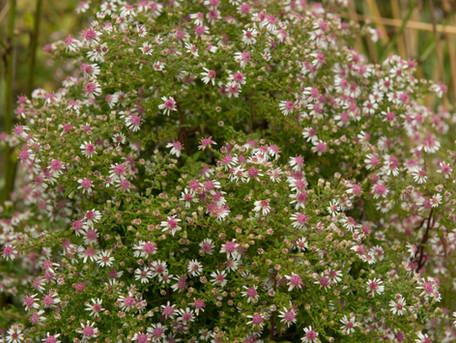Native Plant of the Week: Calico Aster
- Kimberly Simmen
- Jul 27, 2025
- 1 min read
Family: Asteraceae
Name: Symphyotrichum lateriflorum
Bloom Time: Aug-Oct
Flower: White flowers with dark pink or yellow centers
Soil Condition: Moist-dry
Light: Sun, Partial sun
Height: 2-3'
Native Range: Eastern and Central US including Long Island
Zone: 4-8
Photos: first: habit and flower, middle: 'Lady in Black' cultivar with a metallic green sweat bee, last: 'Lady in Black' cultivar with a eastern common bumble bee
Calico aster is a great fall blooming perennial that is also a keystone plant*. The common name comes from the variety of colors of the flowers center discs. The center discs range in color, white, creamy yellow and pinkish red. This plant does prefer afternoon shade or the leaves may scorch.
Maintenance: cut back calico aster 4th of July weekend for a tidier and more floriferous fall show
Benefits: great cut flower, great in a planter, nectar source, pollinators, host to the pearl crescent butterfly and 11 others of moths and butterflies, birds eat the seeds, supports 7 specialist bees
Noteworthy Cultivars: 'Lady in Black' - same flower and habit but with dark purple foliage that emerges in spring and then turns green with a hint of purple
Companion Plants: Echinacea purpurea (purple coneflower), Penstemon hirsutus (hairy beardtongue), Panicum virgatum and cultivars (Switchgrass), Monarda fistulosa (wild bergamot), Rudbeckia subtomentosa (sweet coneflower)
=============================================================
References:
*Keystone Plant: native plants critical to the food web and necessary for many wildlife species to cojmplete their life cycle. (source NWF: for more info: https://www.nwf.org/-/media/Documents/PDFs/Garden-for-Wildlife/Keystone-Plants/NWF-GFW-keystone-plant-list-ecoregion-8-eastern-temperate-forests.ashx?la=en&hash=1E180E2E5F2B06EB9ADF28882353B3BC7B3B247D#:~:text=Keystone%20plants%20are%20native%20plants,to%20complete%20their%20life%20cycle.)

















I need this! I acquired a Lady in Black from you in 2021 and it has faithfully returned, along with my Sneezeweed, acquired elsewhere. This year, none of them appeared. I hope I have seeds squirreled away, but will check if you have this in stock. I can't get to you until after the 8th.
Carolyn Knittel